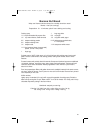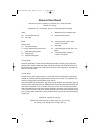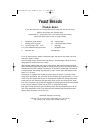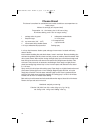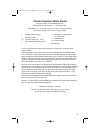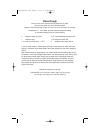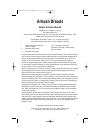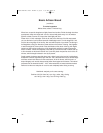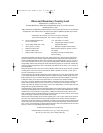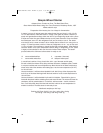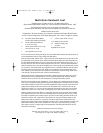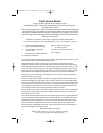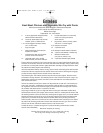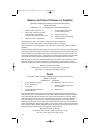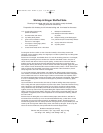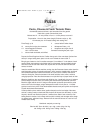38
10 ounces unbleached bread flour
(2-1/4 to 2-3/4 cups)
5 ounces whole wheat flour (1 cup)
1 ounce rye flour (1/4 cup)
2 teaspoons fine sea salt
1 teaspoon instant yeast
1 teaspoon extra virgin olive oil
1-1/4 cups water (10 ounces)
1/2 cup pitted and coarsely chopped
imported black olives
1 tablespoon chopped fresh rosemary
Whole rosemary sprigs for garnish, cut into 1-
inch lengths
Cornmeal for the peel or baking sheet
Flour for dusting
Nutritional analysis per 3-ounce serving:
Calories 249 (from fat 20%) • pro. 7g • carbo. 42g • fat 5g
sat. fat 1g • chol. 0mg • sod. 724mg • fiber 4g
Olive and Rosemary Country Loaf
Adapted from: Charles van Over,
The Best Bread Ever: Great Home Made Bread Using Your Food Processor,
Broadway Books, 1997
Salty olives such as kalamata should be rinsed to remove some of their brine; oil cured olives
will produce a more mellow flavor. Olive lovers may add an additional quarter cup of olives.
Makes one loaf
Preparation: 30 minutes, plus 3 to 3-1/2 hours rising time,
30 minutes baking time, and 1 hour or longer for cooling
Insert the dough blade. Combine the flour, salt, yeast and olive oil in the work bowl. Test the tem-
perature of the flour mixture using an instant read thermometer. Adjust the water temperature so
that the individual temperatures of the flour and water when combined equal 145˚F (i.e. if the flour
is 70˚F, then the water must be 75˚F). This is the base temperature. With the machine running on
dough speed, add the water through the small feed tube and process for 45 seconds. Transfer the
dough to a large ungreased bowl. Cover with plastic wrap and let rise for about 1-1/2 to 2 hours at
room temperature.
Move the uppermost rack of the oven so that it is about 8 inches from the top of the oven and place
a baking stone on the rack. Place a small cast-iron skillet to preheat on the floor or lower rack of
the oven. Preheat the oven to 475˚F.
Scrape the dough onto a lightly floured work surface. Flatten into a 12-inch square using the palms
of your hands. Sprinkle with the chopped olives and chopped rosemary. Fold the dough over onto
itself and knead for 3 to 4 minutes to thoroughly incorporate the olives and rosemary. If the dough
is difficult to knead, cover with a towel and let rest for 10 minutes, then continue kneading.
Form into a round loaf. Sprinkle a cloth-lined basket or banneton with flour. Place the dough in the
basket, with the seam showing on top of the loaf on top. Dust with flour and loosely cover with
plastic wrap. Allow the dough to rise at least 1 hour at room temperature. It will be visibly risen and
spring back when gently pressed with a finger.
Just before baking, gently invert the bread rising basket onto a baker’s peel or the back of a baking
sheet that has been dusted with cornmeal. Sprinkle the top of the loaf with additional flour. Using a
serrated knife, score the dough in a star pattern – starting from the center, make a short 3-inch
slash. Rotate the bread and continue slashing until a star pattern is formed on the top of the dough.
Insert a few sprigs of rosemary into the surface of the dough.
Slide the loaf onto the baking stone, and then carefully pour 1 cup of warm water into the cast-iron
pan in the oven. Reduce the heat to 450˚F. Bake the bread for 30 minutes, and then reduce the
temperature to 425˚F and bake for an additional 15 minutes. The crust will be well browned and the
loaves will sound hollow when tapped on the bottom. The internal temperature of the bread will be
205˚ to 210˚F when tested with an instant read thermometer. Remove the bread from the oven and
place on a rack to cool completely before slicing or storing.
02CU13445 DLC-2011 IB REV 8/4/03 1:50 PM Page 39



